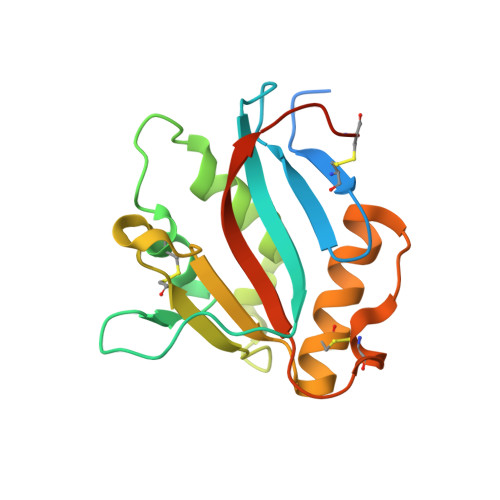Structural Basis for Receptor Selectivity by the Whitewater Arroyo Mammarenavirus.
Shimon, A., Shani, O., Diskin, R.(2017) J Mol Biol 429: 2825-2839
- PubMed: 28736175
- DOI: https://doi.org/10.1016/j.jmb.2017.07.011
- Primary Citation of Related Structures:
5NSJ - PubMed Abstract:
Whitewater Arroyo virus belongs to the "New World" group of mammarenaviruses that reside in rodent reservoirs and are prevalent in North and South Americas. Clades B and A/B of New World mammarenaviruses use transferrin receptor 1 (TfR1) for entry. While all of these viruses use rodent-derived TfR1 orthologs, some can also use the human-TfR1 and thereby infect humans. Although we have structural information for TfR1 recognition by pathogenic virus, we do not know what the structural differences are between the receptor-binding domains of pathogenic and non-pathogenic viruses that allow some but not all viruses to utilize the human receptor for entry. The poor understanding of the molecular determinants of mammarenavirus host range, and thus pathogenicity, is partly due to the low sequence similarity between the receptor-binding domains from these viruses and the limited available structural information that preclude the use of modeling approaches. Here we present the first crystal structure of a receptor-binding domain of a non-pathogenic clade A/B mammarenavirus. This structure reveals the magnitude of structural differences within the receptor-binding domains of TfR1-tropic viruses. Our structural and sequence analyses indicate that the same structural incompatibilities with the human receptor equally affect both pathogenic and non-pathogenic mammarenaviruses. Non-pathogenic viruses do not have specific structural elements that prevent them from using the human receptor. Instead, the ability to utilize the human receptor directly depends on the extent of weak interactions throughout the receptor-binding site that in some viruses are sufficiently strong to overcome the structural incompatibilities.
Organizational Affiliation:
Department of Structural Biology, Weizmann Institute of Science, Rehovot, Israel.


















